Tips for identifying decorative stones -- Minerals
In this section
Rocks are made of minerals, the basic building blocks of the inorganic world. Each mineral has a particular chemical composition, and usually, the atoms are arranged in a regular pattern, giving it a crystal structure. Minerals are identified by their different properties, for example crystal shape, hardness, colour and lustre. Some of the minerals most often found in decorative stones are described here.
Calcite (calcium carbonate) is colourless or white when pure. It is too hard to scratch with a fingernail, but easily scratched with a penknife, and it readily cleaves into rhombohedral fragments. Aragonite is also calcium carbonate but lacks the rhombohedral cleavage. Over time it alters to calcite, the more stable mineral.
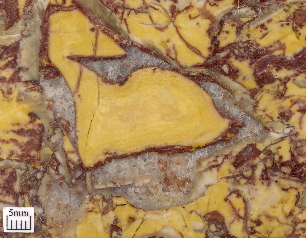
Colourless 'sparry' calcite filling a fossil shell
Dolomite (calcium magnesium carbonate) is colourless or white when pure, and is just a little harder than calcite. It typically forms rhombohedral crystals. It can be hard to tell apart from calcite just by looking.
Gypsum (calcium sulphate) in fine-grained masses is the alabaster of geologists. It is colourless or white when pure, and is so soft it can be scratched with a fingernail.
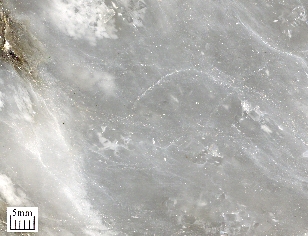
Fine-grained gypsum, what geologists call 'alabaster'
Fluorite (calcium fluorite) is called 'fluorspar' in the commercial trade. It can be various colours, sometimes with zones of different colours in the same crystal. It is harder than calcite but softer than feldspar. Corners readily cleave off the cube-shaped crystals.
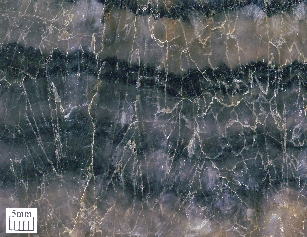
Blue John, a banded variety of fluorite
Hematite (iron oxide) forms metallic silvery grey crystals, but when fine-grained or in powder form, it is brownish red. It is very important for colouring decorative stones. Goethite (iron hydroxide) is yellowish brown to dark brown and whether alone or mixed with hematite, it often colours decorative stones too.
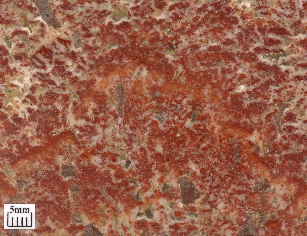
The colouring is caused by red hematite
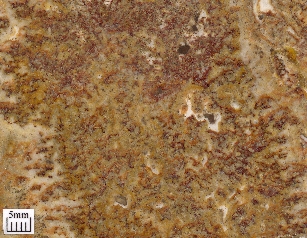
Brown goethite
Quartz (silicon dioxide) is found in many kinds of rock. Pure colourless quartz is called rock crystal, and purple quartz is called amethyst. It is too hard to be scratched with a penknife, and has a curved 'conchoidal' fracture, rather like glass.
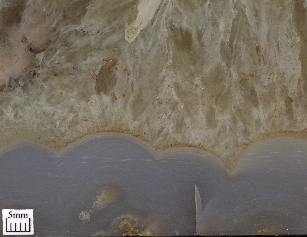
Rock crystal above chalcedony

Amethyst
Very fine grained quartz is known as chalcedony. Jasper, coloured by iron oxides, and banded agate are two decorative kinds of chalcedony.
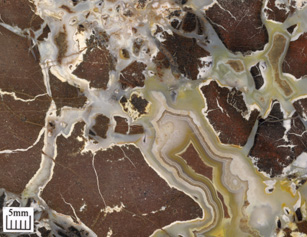
Banded agate cementing fragments of dark brown jasper.
Feldspars are a family of silicate minerals that are especially important in igneous and metamorphic rocks. Those containing potassium (potash feldspars) or sodium are called alkali feldspars. They are mainly pink, cream or white and are typically found in granites. Plagioclase feldspars contain sodium, calcium, or an intermediate composition. They are colourless, white or grey, and sometimes have a multicoloured schiller. Feldspars are almost as hard as quartz and well-formed crystals can appear rectangular in a polished slab of stone.
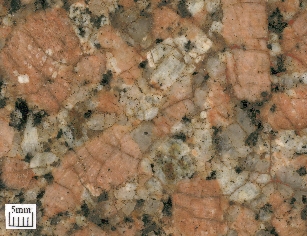
Pink potash feldspar
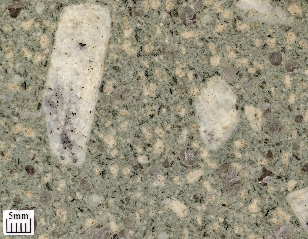
White plagioclase feldspar
Micas are a family of silicate minerals recognised by their shiny crystals that split into very thin sheets. Muscovite is silvery while biotite is brown. They are most common in igneous and metamorphic rocks.
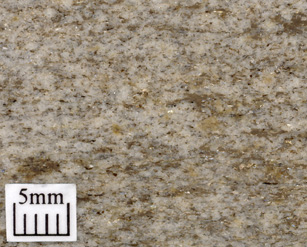
Tiny white flakes of muscovite
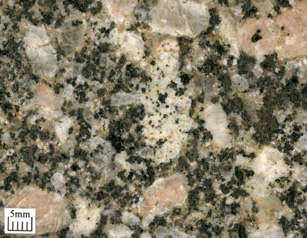
Dark brown biotite
Chlorites, another silicate group, also form sheet-like crystals but they are usually green. They are an important component of some metamorphic rocks. Most serpentines seen in decorative rocks are magnesium silicates. They are yellow to green, usually very fine-grained with a slightly greasy feel, but may form asbestos veins with a fibrous texture. They are important in serpentinite rocks.
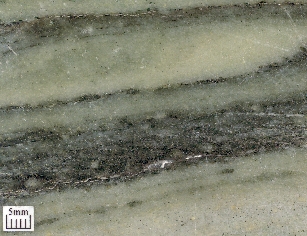
Rocks coloured by chlorite
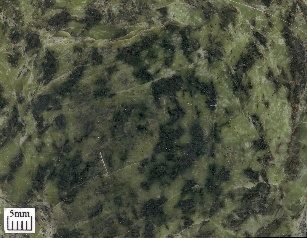
Serpentine
Olivines have a composition between magnesium silicate to iron silicate, and are usually olive green. They are found mainly in igneous rocks as hard grains or rounded crystals. Another family of silicate minerals, the Pyroxenes, are mainly green or brown and are found in igneous and metamorphic rocks. Altered pyroxenes known as 'bastite' can have a bright reflective lustre.
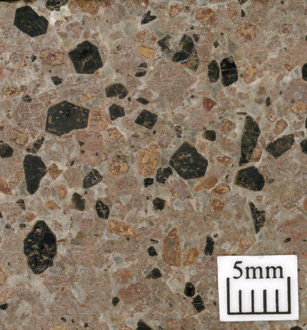
Dark green pyroxene crystals
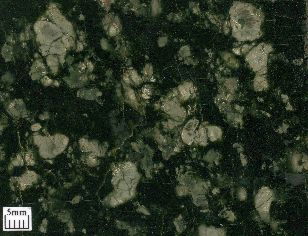
Altered or 'bastitised' pyroxene
The Amphiboles are an important family of silicate minerals that usually form elongate crystals. They includes green actinolite, which is found in metamorphic rocks, and dark green to black hornblende, which occurs in granites and many other igneous and metamorphic rocks.
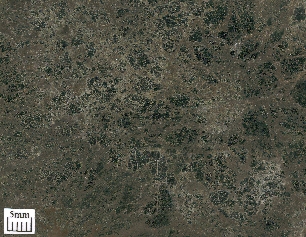
Green actinolite
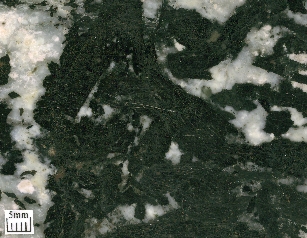
Black hornblende
Epidote (an aluminosilicate mineral) is found as elongate crystals in altered igneous and metamorphic rocks giving them a characteristic pistachio green colour. Its manganese-bearing relative piemontite is dark red and gives certain decorative rocks their purple coloration.
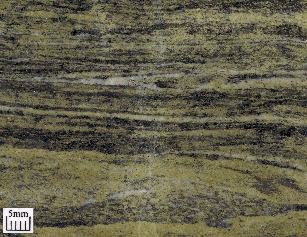
The pistachio green colour is due to epidote
Feldspathoids are a group of silicate minerals which include nepheline, lazurite, sodalite and leucite. Nepheline is hard, typically grey, and has a greasy looking lustre. It is an important component of some igneous rocks called syenites. Lazurite (an aluminosilicate mineral) is the main constituent of lapis lazuli and is bright blue; the blue powder was used for the pigment 'ultramarine'. A closely related mineral sodalite can be a more violet shade of blue and forms a white powder. It is also found in decorative stones although not those available in Corsi's time.
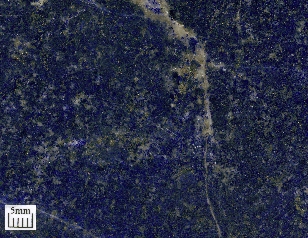
Lazurite in lapis lazuli
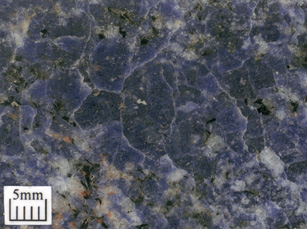
Blue sodalite (not from Corsi's collection)
Leucite occurs as dodecahedral or rounded white crystals scattered through volcanic lava. The last family of silicates mentioned here, the garnets, occur as dodecahedral or rounded hard crystals, and are usually pink, brown, red or black. They are found in certain igneous and metamorphic rocks.
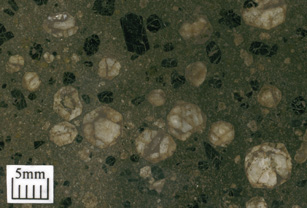
Leucite
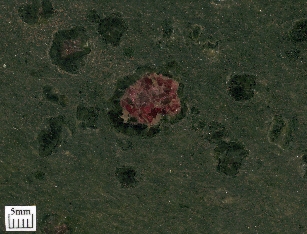
Garnet
For a fun guide about what minerals are and how to identify them, go to the Learning Zone. There are many good books and websites that will help you find out more about minerals and rocks.